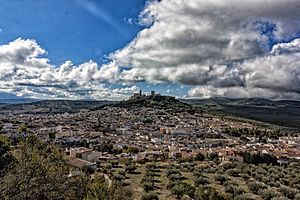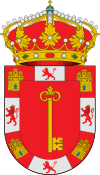Alcalá la Real facts for kids
Quick facts for kids
Alcalá la Real
|
||
|---|---|---|
|
city
|
||

View of the city
|
||
|
||
| Country | ||
| Province | Jaén | |
| Comarca | Sierra Sur de Jaén | |
| Area | ||
| • Total | 262 km2 (101 sq mi) | |
| Elevation | 918 m (3,012 ft) | |
| Population
(2018)
|
||
| • Total | 21,758 | |
| • Density | 83.05/km2 (215.1/sq mi) | |
| Demonym(s) | Alcalaínos | |
| Time zone | UTC+1 (CET) | |
| • Summer (DST) | UTC+2 (CEST) | |
Alcalá la Real is a historic city in the province of Jaén, Spain. It is known for its impressive fortress and rich past. In 2006, about 22,129 people lived there.
Contents
Where is Alcalá la Real Located?
Alcalá la Real is about 71 kilometers (44 miles) from Jaén, the capital of its province. It is also 53 kilometers (33 miles) from Granada. The city sits on the slopes of a hill called La Mota, which is part of the Sierra Sur de Jaén mountains.
The town covers an area of 261.36 square kilometers (100.91 square miles). A large Moorish fortress stands tall over the town. The city grew around this fortress many centuries ago. The Guadalquivir river valley is connected to Alcalá la Real through the Guadajoz river.
A Journey Through Alcalá la Real's History
People have lived in the area around Alcalá la Real for a very long time. Tools and remains from the Palaeolithic (Old Stone Age) to the Bronze Age show human presence. Some even think it was one of the last places where Neanderthal people lived.
Ancient Times: Romans and Early Settlements
The first signs of a town, possibly called Sucaelo, appeared during Roman times. Archaeologists have found interesting items from this period. One famous discovery is a marble statue of Hercules, which is now in a museum in Madrid.
The Muslim Era: Qal'at, the Fortified City
After the Muslims arrived in Spain in 713, the town was renamed Qal'at. This Arabic word means "fortified city." This name shows how important its defenses were.
During the rule of Umayyad caliph Al-Hakam II (971–976), many watchtowers were built. These towers helped protect the city from attacks, including those by Vikings. Today, 12 of the original 15 towers still stand. Around the year 1000, the main tower, called La Mota, became a strong fortress. It was a key defense point for Al-Andalus (Muslim Spain) against the Christian Reconquista. In the 12th century, the city was ruled by the Banu Said family. It became known as Qal'at Banu Said.
The Reconquista and Royal Status
After the caliphate broke into smaller kingdoms, Qal'at became a strong base for the Kingdom of Granada. From here, many raids were launched against Christian areas like Jaén.
The city was finally captured by Christian forces on August 15, 1341. King Alfonso XI of Castile led this victory. He gave the city the special title Real, which means "Royal." This is why it is now called Alcalá la Real.
Changes After the Reconquista
Alcalá remained under the control of Jorquera until 1364. Then, King Peter I gave it its own government council. In 1432, King John II officially made it a city.
After the conquest of Granada in 1492, Alcalá lost some of its importance. It was no longer a key border city. People started moving down from the fortress hill to safer areas, creating the city we see today.
Later, during the Peninsular War (part of the Napoleonic Wars), French troops occupied the fortress from 1810 to 1812. When they left, they burned parts of the upper city, damaging the Abbey Church.
During the Spanish Civil War, Alcalá was taken by the Nationalists. The city suffered a lot of damage because it was close to the fighting.
What to See in Alcalá la Real
Alcalá la Real has many interesting historical places to visit:
- La Mota fortress: This Islamic fortress is on the hill of the same name.
- Alcazaba: A strong, triangular-shaped area with three towers.
- Murallas: Lines of old walls with several towers.
- Palacio Abacial (18th century): This old palace now holds the Museum of Alcalá la Real.
- Pilar de la calle Oteros: A grand fountain from 1746.
- Pilar de la Mora
- Pilar de los Álamos (1552)
- Pilar de la Toquela (1517)
- Roman bridge: An ancient bridge over the Guadalcoton river near the city.
- Batmale House (Early 19th century)
- Casa Pineda: An old Muslim stone building that has been restored.
- Ayuntamiento: The city's Town Hall.
- Convent of San José de los Capucinos (17th century): Now used for city offices and a library.
- Iglesia Mayor Abacial (main Abbey church): Built in 1530, with tall towers.
- Church of San Domingo de Silos: A mix of Gothic and mudéjar styles (1341), with a 16th-century tower.
- Church of San Juan (15th-18th centuries)
- Iglesia de las Angustias ("Church of the Pains"): From 1747.
- Iglesia de Consolación (16th-17th centuries)
- Church of San Antonio (1753)
- Convento de la Encarnación (1630): Built in the Baroque style.
Economy: How Alcalá la Real Makes a Living
The main part of Alcalá la Real's economy comes from olive trees and making olive oil. Other important activities include growing cherries, raising sheep, making crafts, and working with plastics and metals.
The city's economy is growing, but not as fast as some nearby towns. Because of this, many young people from Alcalá la Real move to Granada to find jobs.
Sister Cities
Alcalá la Real has two sister cities:
 Lohfelden, Germany
Lohfelden, Germany Figueres, Spain (since 1989). This connection is because of Pep Ventura, who was born in Alcalá la Real in 1817. He helped modernize the sardana, which is now the traditional dance of Catalonia.
Figueres, Spain (since 1989). This connection is because of Pep Ventura, who was born in Alcalá la Real in 1817. He helped modernize the sardana, which is now the traditional dance of Catalonia.
See also
 In Spanish: Alcalá la Real para niños
In Spanish: Alcalá la Real para niños






